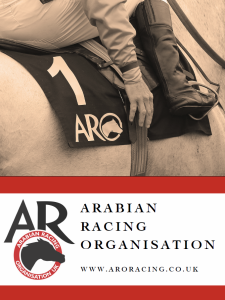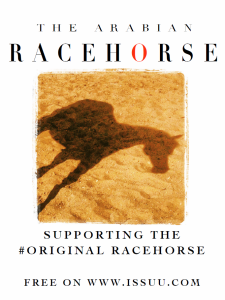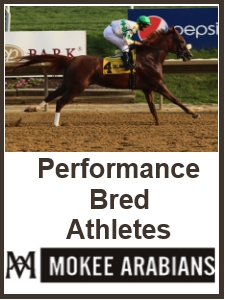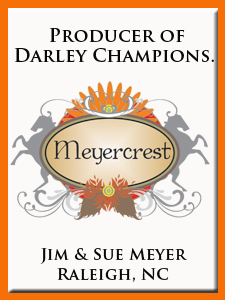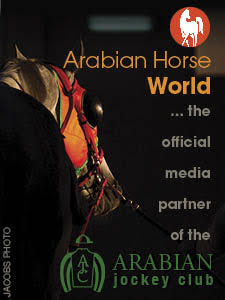Arabian Racing Industry
Arabian racing in North America was organized around 1959. View the History of the Arabian Racehorse.
The Darley Awards were founded ten years ago to honor the best in Arabian horse racing. This distinguished ceremony recognizes the most outstanding race horses, jockeys, trainers and breeders of the Arabian community. Award ceremonies present an opportunity for those involved in Arabian racing to celebrate its virtues and award its best.
Around the Track
Click here for the Leading Track Records Report. It is a free report for those who have registered on our website.
Arabians typically race distances from 4 1/2 furlongs to 1 ¾ miles. The majority of Arabian races are 6 furlongs.
Click here for the Leading Track Records Report. It is a free report for those who have registered on our website.
No, purebred registered Arabians only run against themselves in AJC sanctioned races.
The number of times a horse races varies with the individual animal, but often a trainer will try to race a horse once every 14 days.
Getting Started
How do I find a trainer?
Contact the local race organization for a list of trainers, talk to other owners, or visit our online DIRECTORY HERE. Once you have identified potential trainers, contact the trainer and do not hesitate to visit the training center and interview the trainer to clarify your expectations and working arrangement. Trainers’ standings are frequently published in track programs and on the official track website.
How do I find a jockey?
Generally the trainer recommends and contacts the jockey. An owner or trainer can find a list of jockeys and jockey’s agents in the track condition book. Tracks frequently publish the current jockey standings for each meet in the daily program or on the track’s website.
How do I get licensed?
Contact the racing office of the track where you plan to run. In most states log onto the State Racing Commission website, where instructions are readily available. Owners pay a fee, complete necessary information, have a photo taken and are fingerprinted. Many states now recognize a multi-state license or extended-year license for convenience.
If you have a trainer they will help you with this process.
How do I get silks/colors?
Owners typically design their own silks. One can purchase silks through the racetrack tack shop or racing silks vendors who advertise their services throughout the industry.
Where do I go to buy a race prospect?
Private treaty, magazine ads, auction/sales and claiming races. While interviewing trainers, or after you have selected a trainer, consult with him or her regarding what they have found to be a good race prospect.
Investigate bloodstock agents. Claiming offers a ready-made candidate. Identify and participate with partnerships that claim racing prospects until you have gained the knowledge and confidence to manage your own racing program
How do I pick out a race prospect?
Use the help of your trainer, trusted friend or mentor. Look for basic correct conformation as you would any horse you are buying. Give special attention to good straight legs with, preferably short pastern, short cannon, and long forearm; well laid-back shoulder; deep hip with sloping croup; good width between jaws. A pre-purchase exam is often money well spent.
How much does it cost to enter a race?
Generally there are no entry fees for overnight races, although some tracks have a start or a gate fee.
What are the payout percentages for a race (how much do I win)?
The majority of races pay: 1st (60%), 2nd (20%), 3rd (11%), 4th (6%), 5th (3%). However, this can vary from State to State. Payout percentages are identified in condition books and or stakes books.
How much does it cost to keep a horse in race training?
Training costs can vary widely depending on the trainer, part of the country and whether the horse is at the track or on a farm. Generally, costs will be less on the farm. Included in the daily training fee are feed, bedding, grooming and exercise. Fees for the farrier and veterinarian can vary dramatically.
How do I learn about the tax advantages for Arabian Racing?
The American Horse Council publishes two very good reference books dealing with taxes. They are: “Tax Tips for Horse Owners” and “The Horse Owners Tax Manual”. These publications are the tax references for the equine industry. If you are seriously considering becoming an owner, acquire these publications for your library. For more information, visit the American Horse Council’s website.
How often can my horse run?
Every horse is different. For a mature, healthy horse in its prime you can expect to run every 2-3 weeks.
Who enters my horse?
Your trainer generally enters your horse. Information is contained in the condition book or stakes information on when to enter a horse for a specific race.
How do I get my horse to run in a stakes race?
Each stakes race has its own conditions that govern the entrants of the race. The Organization sponsoring the stakes race will advertise and publish information one can obtain, in order to plan and nominate horses.
The owner and trainer should discuss this.
Who ships my horse from track to track?
The owner pays to ship the horse with the trainer or a third party hauler. You always have the option to haul the horse yourself.
What is a claiming race?
It is a race where all horses entered into the race are for sale for a tag (claiming price set by the racing secretary). Any licensed owner who has sufficient money deposited in the track account where the claim is made may claim (buy) a horse in the race prior to the start of the race.
If more than one claim is submitted on the same horse, then the buyer is chosen at random. The entering owner takes any purse money won in the race. The new owner is responsible for the horse immediately after the start of the race. An owner cannot claim a horse and return it to the same barn/trainer.
How do I claim a horse?
You must have the claiming money in your purse account. You enter the claim in the racing office prior to the start of the race. After the race has been run, a track official meets the claimed horse on the track and transfers the horse to the new training barn representative.
What is a Handicap?
A handicap race is designed to level the playing field by giving higher caliber horses more weight and lesser caliber horses less weight. The racing secretary generally determines the weights. The weights are added to the saddle blanket of the racing horse to reach the accorded handicap weight.
At what age can my horse run?
How young, how old? Arabians can run as three-year-olds and typically cannot run after age eleven.
It is best to verify racing ages with the track’s racing office as each state may have different rules on age and conditions.
Can all Arabian bloodlines run?
While there are preferred, proven bloodlines for racing, there are still many unproven bloodlines.
What does the word “conditions” mean as regards to a race?
The “conditions” say who may run in the race, the weight they will carry and the distance of the race. The types of race offered are described on the AJC website.
Can I bet on my horse?
Yes.
Do Arabians run against Thoroughbreds or Quarter Horses?
Purebred Arabians run only against other Purebred Arabians. The AJC through AHA (registry) issues a certificate for racing. This certificate is issued for racing against other Purebred Arabians only.
How long is a furlong?
One eighth of a mile.
How long is the track?
Depends on the track. Track distances vary from 5/8 mile to 1 mile and up.
Do Arabians run faster or slower than Thoroughbreds?
Arabians are slower than Thoroughbreds. An Arabian will run six furlongs 5-6 seconds slower than a Thoroughbred.
Where do I get a condition book?
Through the racing office at the track.
Which direction do the horses run?
In the United States, horses run counterclockwise.
What happens when the horse can run no more?
Retired racehorses are bred for performance and when retired can be used for showing, endurance pleasure riding and breeding.
What is Lasix and why do horses run on it?
EIPH (exercise induced pulmonary hemorrhage) is prevalent (75%+) in all horses competing at high levels. Lasix (Salix) is a diuretic that is generally used to control or prevent this bleeding in the lungs.
More information on medication in racing horses can be found at the Racing Medication Testing Consortium website.
How long does it take to condition a horse before its first race?
A horse with no previous training will take anywhere from five to six months or more for proper conditioning.
Starting and conditioning a racehorse varies with the individual horse and it’s foundation, early training, soundness, confidence and maturity. Once a horse is under saddle and has built a solid foundation (adjustment to training, walk, trot and canter, changing leads, building bone and muscle and a cardiovascular system- which will enable it to run at it’s potential), a racehorse will move into speed, increasing distances on the track and further training including gate work and paddock training.
After accomplishing these goals, the trainer can best determine the average time your racehorse will run his or her first race. On average, this event occurs between the 4th and 8th month.
How do you start a young horse?
Opinions vary but often a racehorse is started just as you would any riding horse. The horse will not race forever and it is easier to use them for other disciplines if the basics are already there. Start with basic groundwork, breaking to saddle and begin trotting and galloping. Gradually increase the time you trot and gallop until the horse is very fit.
Are there clinics and seminars available to help new owners?
Yes, periodically each state will hold new owners seminars. Additionally, other breed organizations, tracks and Schools of Veterinary Medicine have seminars that Arabian owners, trainers and staff attend for continuing education.
Contact the state affiliate or the AJC for further information.
How do partnerships work?
Partnerships are a wonderful way to experience the thrill and fun of racing while splitting the costs among partnership members. Partnership managers mange all aspects of race horse ownership… choosing horses, choosing trainers, choosing races, managing finances, licensing owners, offering social events for its partnership managers, and being available to mentor partnership members who are new to racing. Read our PARTNERSHIP MANAGER bios at our ONLINE DIRECTORY.
Where do Arabians race?
In the US, Arabians currently have organized race meets in TX, DE, CA, CO, MI, Check with the specific organization for the meet schedules. Links to state affiliates websites can be found on the AJC website under State Affiliates.
The AJC website will carry a general outline of race meet dates for each state and a Calendar of all stakes races as well as Graded Stakes races. For more specific conditions and dates contacdt the state affiliate
What organizations promote Arabian racing?
The organizations that are dedicated to Arabian Racing are; the Arabian Jockey Club (AJC), the Arabian Racing Cup (ARC), the Arabian Horse Association (AHA), the Eastern Arabian Racing Association (EARA), the Arabian Racing Association of Florida (ARAF), the Texas Arabian Breeders Association (TABA), the Arabian Racing Association of California (ARAC), the Colorado Owners and Breeders of Racing Arabians (COBRA), the Association of Racing Arabian Breeders of Michigan (ARAB) and the Arabian Racing Association of Minnesota (ARAM).
The Money Factor
The horse market fluctuates with the economy, time of year, part of the country, age, gender and pedigree of the horse, etc. However, it is possible to find a quality horse for $5,000 to $15,000. Typically, for $15,000 to $20,000, you could purchase a racing prospect with outstanding blood lines, conformation, and potential.
Even on the high end, over $20,000 (which would include a stakes winning horse) investing in a quality Arabian race horse costs much less than the same quality Thoroughbred.
Racing is a gamble, but with ever increasing purses, there is also an increased opportunity to make money. If you are getting involved in racing only to make money, you would be wise to invest your money elsewhere. Most people are involved in racing because they love Arabian horses and the sport, and they enjoy the thrill of watching their own horses compete.
Training costs can vary widely depending on the trainer, part of the country, and whether the horse is at the track or on a farm. Generally, costs will be less on the farm. Included in the daily training fee are feed, bedding, grooming, and exercise. Fees for the farrier and veterinarian can vary dramatically. The following estimates are meant only as a guideline.
On The Farm
Farrier: $25-$40 trim every 4 wks.
Vet Care: $0-$75 Routine per month
Misc. Fees: $25-$125
Monthly Expenses: $825-$1635
At The Track
Farrier: $100-$135 shoes every 4 wks.
Vet Care: $100- $350 routine per month
Misc. Fees: $50-$200
Monthly Expenses: $1,645-2,545
The Right Horse
The majority of horses are bought privately. You could contact a blood stock agency who will look for and arrange the sale of horses for you. If you want to find a horse yourself, you could look in magazines and newspapers for horses for sale. You could also contact your state association for breeders in your area. A second way to purchase a horse is through a public auction. You can get a catalogue of horses to find the ones you are interested in and then inspect them at the open barns before the sale. The horses are sold one at a time to the highest bidder. The third way to acquire a horse is in a claiming race. Horses entered into this kind of race can be purchased for the price stated in the race conditions. After filing a claim, the horse is yours once it leaves the starting gate, but any money won in that race goes to the previous owner. One final way of acquiring a horse is by breeding your own. By doing this, you can select the specific blood lines you want and you raise the horse yourself. However, breeding and raising your own horse takes a tremendous amount of time, money, and commitment. From the time you breed the mare until the horse is old enough to race, you have already spent four years, and a lot can happen in that time.
If you are not quite ready to commit to sole ownership of a horse, you could lease a horse. Here you pay all the expenses, but you also reap all the rewards. You do not officially own the horse, so it is not as great a commitment. Another great way to get involved is through a partnership with an experienced owner. That way, you can get your feet wet by sharing expenses and revenues, learn about the business, and still have the thrill of victory.
With a race horse, it is important to have correct conformation, but it is possible to have Arabian breed characteristics along with an athletic build. Overall balance is very important, and when you look at the horse, all the “pieces” should fit together proportionally. Ideally, the horse will have a prominent wither with a long, angular shoulder which allows for more freedom of movement and a longer stride. The forearm should be long and muscular in relation to a short, flat cannon bone. The pastern should not be too long or too short and have an angle similar to the shoulder. When viewed from the front, the legs should be parallel, and when viewed from the side, they should be relatively straight. The horse should have a wide chest and deep heart girth to allow room for greater heart and lung capacity. The hip should be long, but not flat, and the hindquarters should be well muscled. The hind leg should be similar to the front with a muscular gaskin, short, flat cannon bone, and properly angled pasterns.
A wide variety of blood lines have been successful on the racetrack. Polish, Russian, and French bred horses have been successful because these countries have been breeding for racing for over 100 years. Crabbet line horses (bred by the Crabbet Stud in England) have also been successful, and some Egyptian lines have proved themselves as well. Often, people breed a combination of lines.
Unfortunately, there is no 100% accurate test to see if your horse is racing material. If you choose to put your horse in training, usually a trainer will have an idea of his ability within about 90 -120 days.
No, only registered purebred Arabians are eligible to race in the United States.





